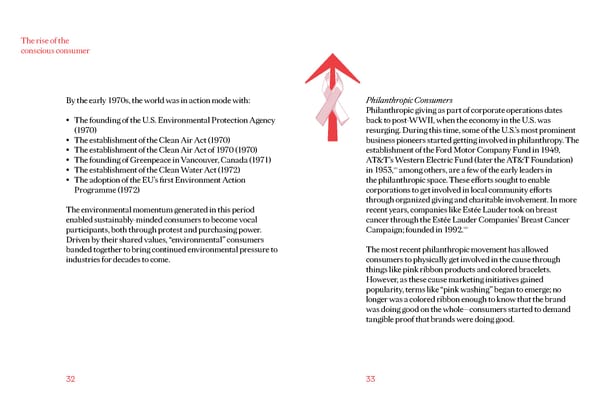The rise of the conscious consumer By the early 1970s, the world was in action mode with: Philanthropic Consumers Philanthropic giving as part of corporate operations dates • The founding of the U.S. Environmental Protection Agency back to post-WWII, when the economy in the U.S. was (1970) resurging. During this time, some of the U.S.’s most prominent • The establishment of the Clean Air Act (1970) business pioneers started getting involved in philanthropy. The • The establishment of the Clean Air Act of 1970 (1970) establishment of the Ford Motor Company Fund in 1949, • The founding of Greenpeace in Vancouver, Canada (1971) AT&T’s Western Electric Fund (later the AT&T Foundation) • The establishment of the Clean Water Act (1972) i n 1953,(21) among others, are a few of the early leaders in • The adoption of the EU’s first Environment Action the philanthropic space. These efforts sought to enable Programme (1972) corporations to get involved in local community efforts through organized giving and charitable involvement. In more The environmental momentum generated in this period recent years, companies like Estée Lauder took on breast enabled sustainably-minded consumers to become vocal cancer through the Estée Lauder Companies’ Breast Cancer participants, both through protest and purchasing power. Campaign; founded in 1992.(22) Driven by their shared values, “environmental” consumers banded together to bring continued environmental pressure to The most recent philanthropic movement has allowed industries for decades to come. consumers to physically get involved in the cause through things like pink ribbon products and colored bracelets. However, as these cause marketing initiatives gained popularity, terms like “pink washing” began to emerge; no longer was a colored ribbon enough to know that the brand was doing good on the whole—consumers started to demand tangible proof that brands were doing good. 32 33
 Making Brands Matter Page 16 Page 18
Making Brands Matter Page 16 Page 18